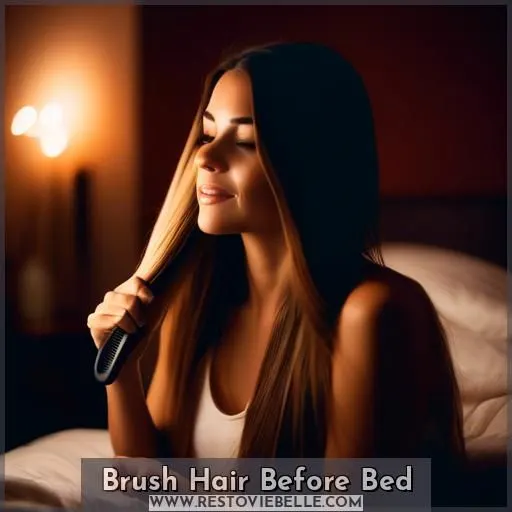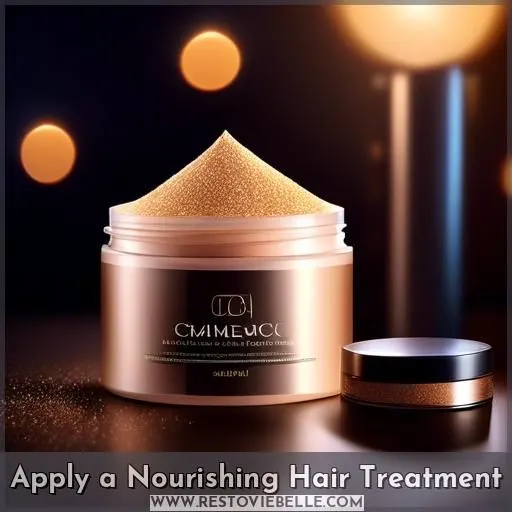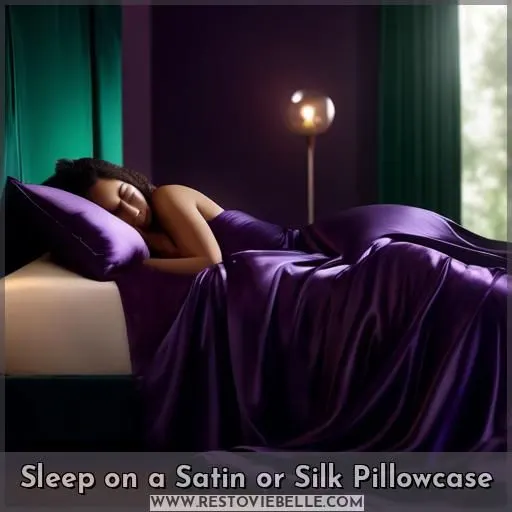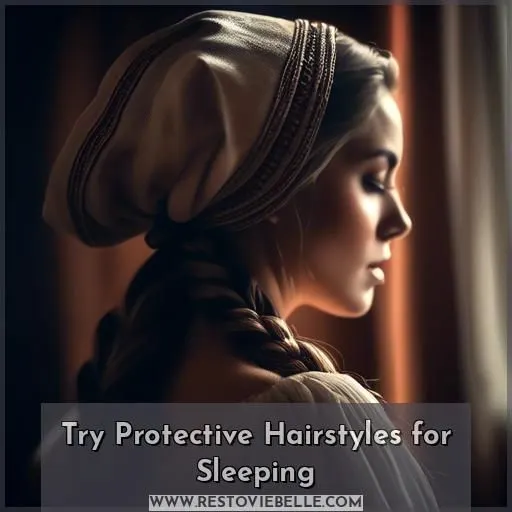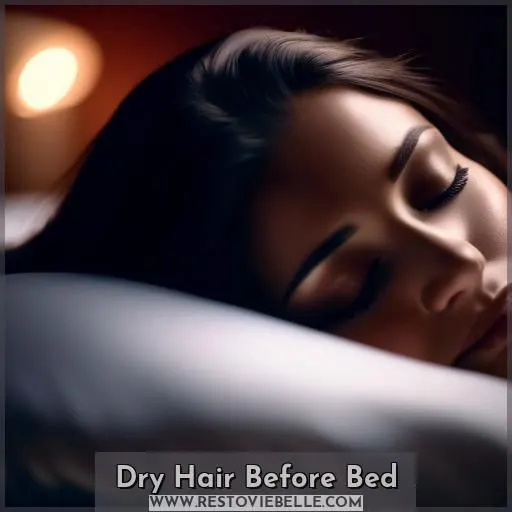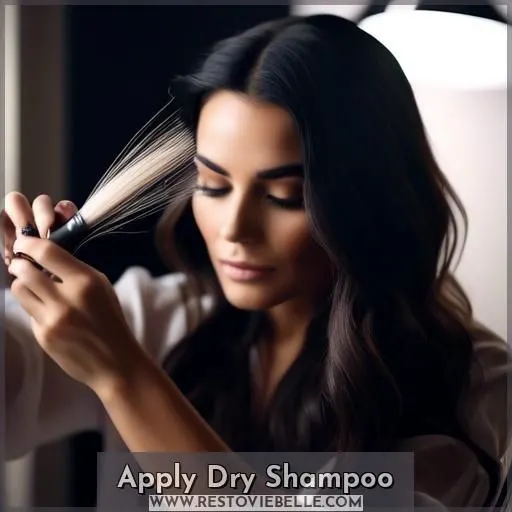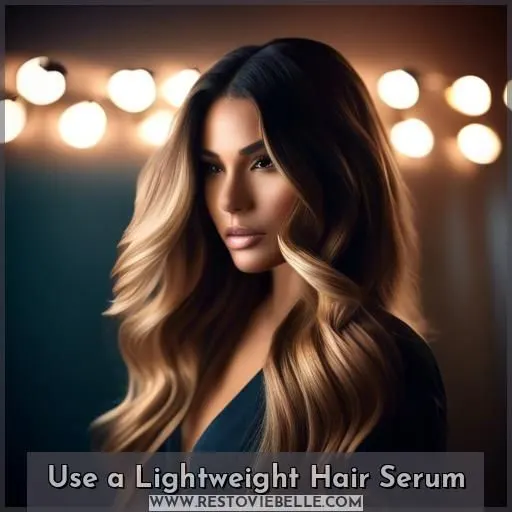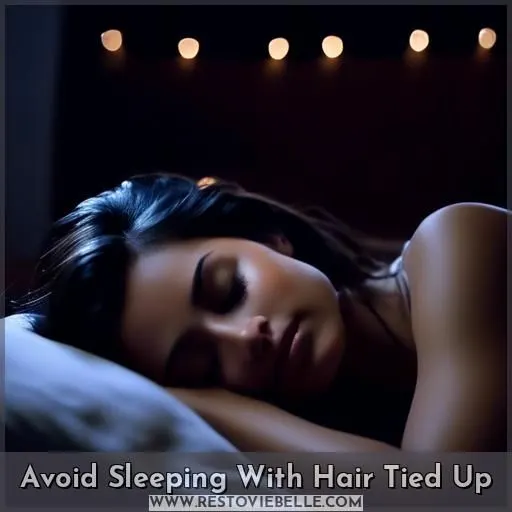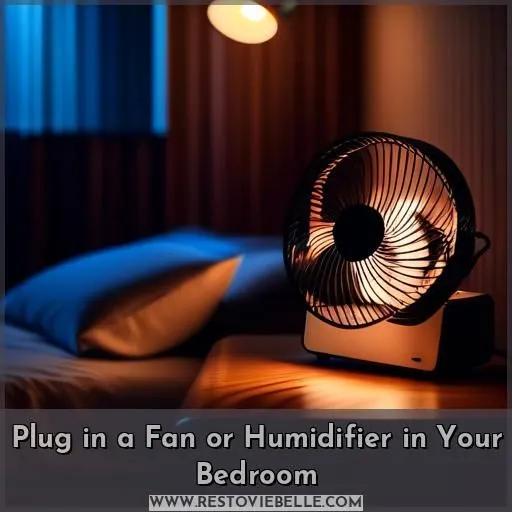This site is supported by our readers. We may earn a commission, at no cost to you, if you purchase through links.
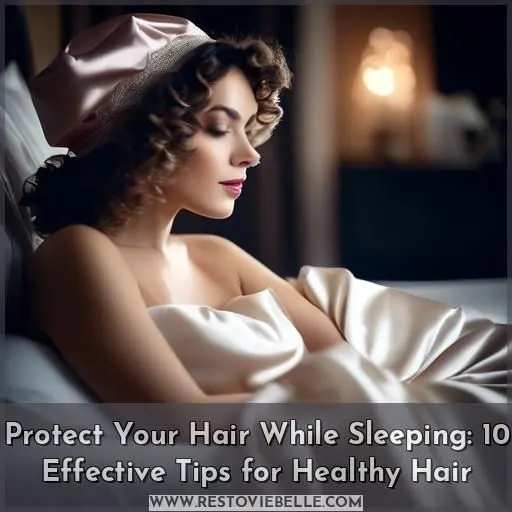
To protect your hair while sleeping, consider using a silk or satin pillowcase. Brushing your hair before bed can also help prevent tangles and breakage. Applying a nourishing hair treatment, such as a deep conditioning mask or hair oil, can help nourish and strengthen your locks.
Sleeping on a satin or silk pillowcase can reduce friction and prevent hair from becoming dry and frizzy. Additionally, try protective hairstyles like braids, twists, or a loose low bun to minimize tangles and breakage while you sleep.
Avoid sleeping with wet hair or tying it up too tightly, as this can lead to damage. Consider using a lightweight hair serum or dry shampoo to help maintain your style and keep your hair looking fresh.
For an extra touch, plug in a fan or humidifier in your bedroom to maintain favorable hair conditions. By incorporating these tips into your nightly routine, you’ll be well on your way to healthier, more vibrant hair.
Table Of Contents
- Key Takeaways
- How to Protect Hair While Sleeping?
- Use a Silk or Satin Pillowcase
- Brush Hair Before Bed
- Apply a Nourishing Hair Treatment
- Sleep on a Satin or Silk Pillowcase
- Try Protective Hairstyles for Sleeping
- Dry Hair Before Bed
- Apply Dry Shampoo
- Use a Lightweight Hair Serum
- Avoid Sleeping With Hair Tied Up
- Plug in a Fan or Humidifier in Your Bedroom
- Frequently Asked Questions (FAQs)
- How does using a silk or satin pillowcase help protect hair while sleeping?
- What are the benefits of applying a nourishing hair treatment before bed?
- How does sleeping on a satin or silk pillowcase reduce friction and tangling?
- What are some gentle hairstyles to protect hair while sleeping, and what materials should be avoided?
- What are the benefits of using a lightweight hair serum to minimize frizz while sleeping?
- Conclusion
Key Takeaways
- Use a silk or satin pillowcase to reduce friction and prevent tangles.
- Brush your hair before bed to detangle and distribute natural oils.
- Apply a nourishing hair treatment to condition and protect your hair.
- Try protective hairstyles like braids, twists, or a loose low bun to minimize tangles and breakage while you sleep.
How to Protect Hair While Sleeping?
To protect your hair while sleeping, use a silk or satin pillowcase or scarf to reduce friction and prevent breakage. Detangle your hair before bed and apply a nourishing hair treatment to keep it moisturized. Avoid using tight hairstyles or elastic bands, and consider using a humidifier to add moisture to the air. Brush your hair gently before bed to distribute natural oils and prevent tangles.
Use a Silk or Satin Pillowcase
Swapping to a silk or satin pillowcase can notably decrease hair damage. These fabrics possess finer fibers that hinder tangles and lessen friction, which could induce breakage. Although they might be a monetary investment, the delicate material inhibits mold and aids in retaining moisture within your hair. Silk and satin pillowcases are a judicious expenditure for anyone anxious about hair well-being.
Swapping to a silk or satin pillowcase can notably decrease hair damage. These fabrics possess finer fibers that hinder tangles and lessen friction, which could induce breakage.
Although they might be a monetary investment, the delicate material inhibits mold and aids in retaining moisture within your hair.
Silk and satin pillowcases are a judicious expenditure for anyone anxious about hair well-being.
Brush Hair Before Bed
Brushing your hair before bed is essential for maintaining its well-being. Here’s why:
- Detangles hair: Brushing removes tangles, reducing the likelihood of breakage and damage.
- Scalp health: Brushing stimulates the scalp, promoting blood flow and hair growth.
- Overnight brushing: Brushing before bed allows natural oils to spread evenly, nourishing your hair.
Don’t neglect to brush your hair before bed to ensure a restful night for your hair. Dry shampoo can be used in place of washing, and overnight treatments can be applied to further nourish your hair. Protective hairstyles, such as loose braids or buns, can also help shield your hair while you sleep.
Apply a Nourishing Hair Treatment
To keep your hair healthy while you sleep, apply a nourishing hair treatment. These products can help condition your hair, improve its texture, and protect it from damage. If you’re unsure about which product to use, consider consulting a hair care professional for personalized advice.
Leave-in products like conditioners and hair masks can provide long-lasting benefits, while hair serums and essential oils can help seal in moisture and prevent frizz.
Sleep on a Satin or Silk Pillowcase
Sleep on a satin or silk pillowcase to reduce friction and protect your hair from breakage. These fabrics are gentler on your hair, preventing tangles and damage. Silk or satin pillowcases also help maintain moisture in your hair, keeping it healthier.
If you prefer, you can also wrap your hair in a silk or satin scarf or use a hair bonnet to further protect your hair while you sleep.
Try Protective Hairstyles for Sleeping
To protect your hair while sleeping, try these protective hairstyles:
- Overnight braids: Create waves on type 2 and 3 hair, stretch type 4 hair.
- Twists: Add flair and protect natural hair.
- Loose low bun or ponytail: Keeps ends tucked away.
- Doobie wrap: Preserves styles and keeps hair hydrated.
Remember to avoid tying your hair up too tightly, as this can strain your scalp and damage your hair. Instead, opt for gentle hair accessories that reduce friction, like silk or satin scrunchies. Use a leave-in conditioner or hair wrap to lock in moisture overnight. Embrace these protective hairstyles for healthy, beautiful hair.
Dry Hair Before Bed
Dry hair before bed to minimize breakage and damage. Hair is at its weakest when wet, making it more susceptible to breakage. Wet hair is also more prone to tangling, which can lead to further damage when brushing or combing. By allowing your hair to dry before going to sleep, you reduce the risk of breakage and tangles.
To dry your hair before bed, you can use a hairdryer on a low setting or let it air dry. Alternatively, you can use a microfiber towel to gently blot excess moisture from your hair. Avoid rubbing your hair with a towel, as this can cause friction and lead to breakage.
In addition to drying your hair before bed, consider using a leave-in conditioner or hair serum to add moisture and protect your hair from breakage. These products can help to detangle your hair and reduce the risk of damage during the night.
Apply Dry Shampoo
Before hitting the hay, apply dry shampoo to absorb oils and sweat from your dry hair. This reduces the need for washing, which can strip your hair of its natural oils and lead to breakage. For long hair, consider using scrunchies instead of bobbles to avoid tension and damage. Dry shampoo can also hydrate your hair, add volume, and refresh your style.
Just remember to avoid acidic components and heavy protein additives in your dry shampoo to maintain healthy hair.
Use a Lightweight Hair Serum
To keep your hair healthy while sleeping, use a lightweight hair serum. This product can help control frizz and retain moisture, keeping your hair hydrated and preventing split ends. Apply it to your hair before bed, and consider using a fan to help the serum penetrate your strands.
If you’re wearing your hair in a top knot or loose braid, avoid using metal clips or elastics, which can cause damage. Instead, secure your hair with a fabric scrunchie or a silk or satin scarf.
By incorporating a lightweight hair serum into your nighttime routine, you’ll wake up with smoother, healthier hair.
Avoid Sleeping With Hair Tied Up
Avoiding sleeping with your hair tied up is essential for maintaining healthy hair. Tension headaches and scalp irritation can occur when your hair is pulled tightly against your head, leading to breakage and damage. Instead, opt for loose hairstyles like a loose ponytail or braid, or a loose top knot.
Silk or satin scrunchies are a better alternative to traditional hair ties, as they’re gentler on your hair. If you must sleep with your hair tied up, make sure it’s loose and secure enough to prevent tangling but not so tight that it causes discomfort or damage.
Plug in a Fan or Humidifier in Your Bedroom
Fans can help circulate the air, reducing humidity and preventing mold growth. Humidifiers, on the other hand, add moisture to the air, which is beneficial for hair health.
Aim for a room humidity level of 40-60% for the best sleep comfort and hair health. Place the humidifier near your bed, but make sure the fan noise doesn’t disrupt your sleep.
Plug in a fan or humidifier in your bedroom to maintain the right air quality for healthy hair.
Frequently Asked Questions (FAQs)
How does using a silk or satin pillowcase help protect hair while sleeping?
Using a silk or satin pillowcase can help protect your hair while sleeping by reducing friction, preventing tangles, and keeping your hair hydrated. Unlike cotton pillowcases, which absorb moisture and can cause breakage, silk and satin pillowcases don’t absorb moisture and stay cool and dry all night long, keeping your skin and hair hydrated.
The smooth surface of these pillowcases allows your hair to glide across the surface, leading to less breakage and more length retention. Additionally, the non-absorbent nature of satin allows your hair to retain its moisture, which is essential for healthy hair.
What are the benefits of applying a nourishing hair treatment before bed?
Applying a nourishing hair treatment before bed can provide several benefits for your hair. These treatments are designed to deeply penetrate and repair hair fibers, enhancing moisture retention and substantially repairing damage.
They can also reduce hair breakage, detangle hair, and improve overall hair health.
By incorporating an overnight hair mask into your routine, you can achieve luscious, healthy locks while you sleep.
How does sleeping on a satin or silk pillowcase reduce friction and tangling?
Sleeping on a satin or silk pillowcase lets your hair glide smoothly, reducing friction and tangling. It’s like your hair’s having a slumber party with its besties, minus the drama and knots.
What are some gentle hairstyles to protect hair while sleeping, and what materials should be avoided?
To protect your hair while sleeping, consider gentle hairstyles that avoid damage and tangling. Some options include braids, loose buns, and wrapping hair in a silk or satin scarf. Avoid metal clips and elastics, and try using a fabric scrunchie instead.
Additionally, consider using a leave-in conditioner or dry shampoo to absorb oils and sweat. Brush your hair before bed to detangle and distribute natural oils, and avoid sleeping with wet hair.
Invest in a silk or satin pillowcase to reduce friction and prevent tangles.
What are the benefits of using a lightweight hair serum to minimize frizz while sleeping?
Using a lightweight hair serum to minimize frizz while sleeping is beneficial because it helps to seal in moisture and prevent friction between your hair strands. This can lead to smoother, more manageable hair in the morning.
Additionally, a lightweight serum is less likely to weigh down your hair or cause product buildup, which can contribute to frizziness. By applying the serum before bed, you can allow it to work overnight, providing an extra layer of protection against environmental factors that can cause frizz, such as humidity or friction from your pillowcase.
Conclusion
Did you know that up to 80% of hair damage occurs while you sleep? To protect your hair while sleeping, consider using a silk or satin pillowcase, brushing your hair before bed, and applying a nourishing hair treatment.
Additionally, try protective hairstyles like braids, twists, or a loose low bun to minimize tangles and breakage while you sleep. Dry your hair before bed, avoid sleeping with wet hair or tying it up too tightly, and consider using a lightweight hair serum or dry shampoo to help maintain your style.
For an extra touch, plug in a fan or humidifier in your bedroom to maintain favorable hair conditions. By incorporating these tips into your nightly routine, you’ll be well on your way to healthier, more vibrant hair.

